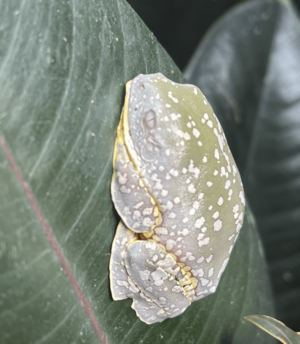Fringe tree frog facts for kids
Quick facts for kids Fringe tree frog |
|
|---|---|
| Conservation status | |
| Scientific classification | |
| Synonyms | |
|
Cruziohyla craspedopus, also known as the fringed leaf frog or fringed tree frog, is a special type of frog. It belongs to a group of frogs called Phyllomedusinae. This amazing frog lives in the Amazon rainforest lowlands. You can find it in countries like Brazil, Colombia, Ecuador, and Peru. It might also live in Bolivia.
Contents
What Does This Frog Look Like?
The fringed leaf frog has some unique features that help you tell it apart from other frogs. Adult male frogs are usually about 5.3 to 6.6 centimeters (2.1 to 2.6 inches) long. Female frogs are a bit bigger, measuring about 6.8 to 7.6 centimeters (2.7 to 3.0 inches) long.
Its head is a little wider than it is long. The front of its face looks quite flat when you see it from the side. This frog has webbed fingers and toes, which help it climb and move around. It also has cool skin flaps on the back of its legs, near its ankles. These flaps form irregular spurs.
During the day, the frog's back is a dark green color. It has large, uneven patches of pale blue-grey that look like lichen on a tree. Its sides have thin black lines. The undersides of its body and the hidden parts of its legs are bright yellow. When the frog sticks to a surface, it can hide its yellow color. This helps it blend in and stay hidden from predators.
How Does This Frog Change Color?
The fringed leaf frog has an amazing ability to change its color very quickly. At night, its skin turns a deep burgundy (reddish-brown) color. This quick color change is mainly controlled by a hormone called intermedin. This hormone affects special cells in its skin called chromatophores.
There are different types of chromatophore cells:
- Xanthophores help with yellow and red colors.
- Iridophores reflect light, making the skin look shiny or iridescent.
- Melanophores contain dark pigment (melanin).
These cells work together to show or hide certain colors. When the frog wants to be darker at night, tiny dark particles inside the melanophores move outwards. This covers the light-reflecting iridophore layer, making the frog appear darker. When the frog wants to be lighter, these dark particles move back inwards. This allows the light-reflecting layer to show, making the frog's skin lighter very quickly. This helps the frog camouflage itself both day and night.
History of Its Name
The fringed leaf frog has had a few different scientific names over the years! It was first named Phyllomedusa craspedopus in 1957 by a scientist named Funkhouser. Later, in 1968, Duellman called it Agalychnis craspedopus. In 2005, Faivorvich named a similar frog Cruziohyla calcarifer. Finally, in 2018, Andrew Gray confirmed its current name, Cruziohyla craspedopus. Andrew Gray also identified a new species in 2018, called Cruziohyla sylviae. This new species was once thought to be the same as Cruziohyla craspedopus.
Where Does This Frog Live and How Is It Protected?
The fringed leaf frog lives high up in the trees of primary tropical lowland rainforests. It can be found at elevations from about 50 to 600 meters (160 to 1,970 feet) above sea level. It only comes down to lower branches when it's time to breed. Breeding happens in fallen trees that have small pools of water. However, young tadpoles have also been found in small water pools on the ground.
This frog lives in several protected areas. These include the Yasuni National Park in Ecuador and the Manú National Park in Peru. These parks help keep its habitat safe.
The Cruziohyla craspedopus is currently listed as "Least Concern" on the IUCN Red List of Threatened Species (from 2004). This means it's not in immediate danger of disappearing. However, it is a rare species, and its population seems to be shrinking. While it doesn't face huge threats, it can suffer from habitat loss in some places. This loss is often caused by human activities like farming.
See also
 In Spanish: Rana de hoja amazónica para niños
In Spanish: Rana de hoja amazónica para niños




